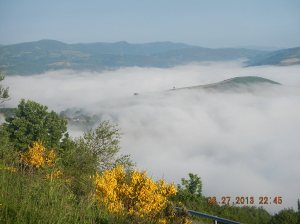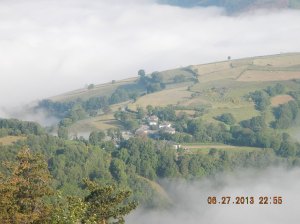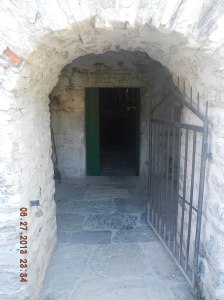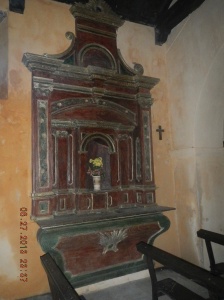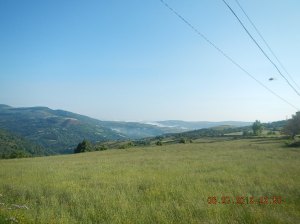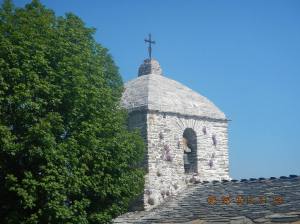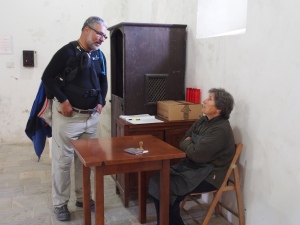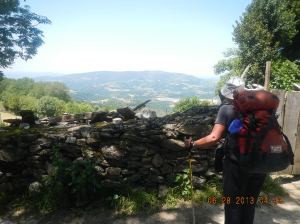Stage 30 – O Cebreiro – Triacastela
Total Distance – 21.3 km (13.2 miles)
Adjusted for Climb – 22.3 km (accrued ascent 200 m = 1 km)
High Point: O’Cebreiro at 1,330 m (4,363 feet)
CLICK ON THE PICTURES TO ENLARGE TO FULL-SIZE
Please note that some names may be in Galician – you’ll now it when you see it.
Finally were we firmly in Galicia – the promised land! The stage before us had some initial climbs before it went almost completely downhill and frankly I didn’t mind that at all. Usually I’m weary of downhill stages because that’s when you tend to get hurt but I was so happy to be in Galicia, every step taking me closer to Santiago, that I didn’t care. I did begin to notice that the churches that we were starting to see in Galicia were much smaller and older than others on the Camino. Also the countryside was greener – those Atlantic winds and storms being caged in by the mountains made Galicia a green haven.
We started the day in a heavy mist and everything from O Cebreiro down was socked in.
Soon we were on a forested trail.
 The first village that we saw was called Liñares. Dating back to at least the 8th century – we know this because it was mentioned in an 8th centruy document – and mentioned in the 12th century Codex Calixtinus or Liber Sancti Jacobi – Liñares was named for its flax fields that provided linen.
The first village that we saw was called Liñares. Dating back to at least the 8th century – we know this because it was mentioned in an 8th centruy document – and mentioned in the 12th century Codex Calixtinus or Liber Sancti Jacobi – Liñares was named for its flax fields that provided linen.
All along the ridge we were to see fields with Scotch broom and spiky green plants that I found out later were wild absinthe.
The iglesia San Esteban in Liñares was built prior to 1120 and restored in 1963.
After a brief stop at the iglesia San Esteban we were soon on the move again. At the Alto San Roque (1,270 meters, 4,166 feet) were were soon upon the Monumento do Peregrino. This large statute on a stone base is a tribute to all the peregrinos who decide to walk the Camino. As you can see from the pictures below the statute represents a peregrino with his satchel and hat, balancing himself on a walking stick while fighting the elements, the winds, rain, snow or sleet, that stand between him and his destination. At the time I just stood there to take it all in I wasn’t thinking; “Hey, that’s me!” but now with the fullness of time I can honestly say, “Hey, that was me!!”
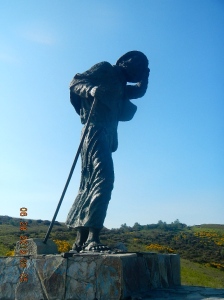
I think the statute was also telling me, “You’ve made it this far, past all the really difficult obstacles, now it’s time to bring it home to Santiago!”
Continuing on to another 2 kilometers past this monument we came to the village of Hospital da Condesa (in Spanish, Hospital de la Condesa). This village was the site of a pilgrim hospital that was established here in the 9th century by the Condesa doña Egilo, the wife of the Conde Gatón. The only remains of that hospital is la iglesia parroquial de San Xoán (San Juan) . This church is laid out in the form of a Latin cross and has an exterior stairwell that leads to a cupola. The church once belonged to the Knights Hospitalers of St. John of Malta..
Soon we were approaching the hamlet of Padornelo which although in 1985 had 3 inhabitants had been the home at one time a priory of the Hospitallers of San Juan de Jerusalén.

Sue taking a picture of the bulls in Padornelo. I affectionately like to call this picture, “The Boys are Back in Town!”
Alto do Poio pass (1,337 meters, 4,386 feet) and there we stopped again to see a very rustic chapel.
At this point although we had 12.5 kilometers to go to reach Triacastela our final destination we were feeling really strong and as a result we flew and covered the 12.5 kilometers in a little over 2 hours.


